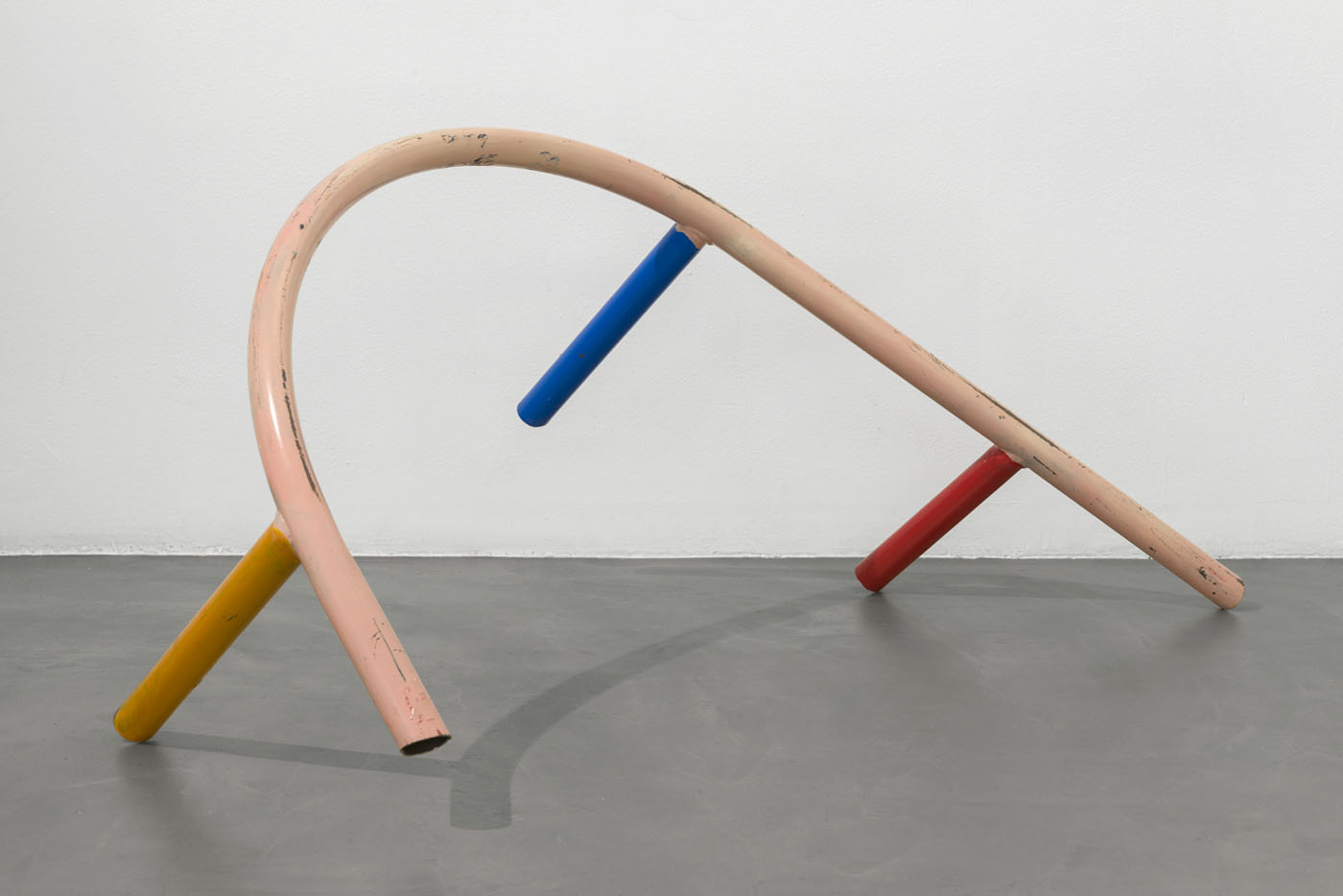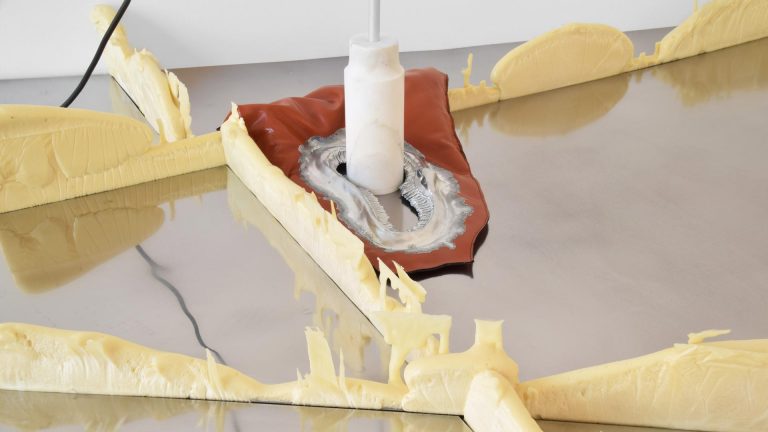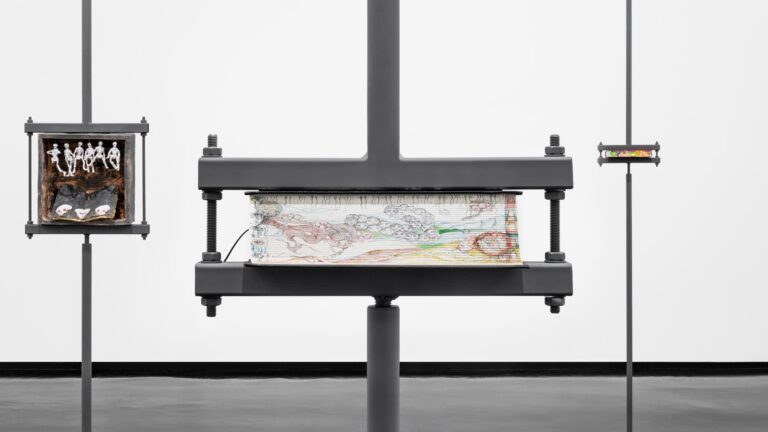Artists: Stefano Perrone, Przemek Pyszczek
Exhibition title: In Conversation Chapter #1
Curated by: Domenico de Chirico
Venue: RIBOT, Milan, Italy
Date: March 11 – May 2, 2020
Photography: all images copyright and courtesy of the artist and RIBOT
“The death of another man singles me out and calls me into question, as though I had become, for my potential indifference, the accomplice of this death, invisible to the other who exhibits himself to you; and as though, even before being destined for it, I had to answer for the death of the other person: as though I had not to leave him alone in his mortal loneliness.”
E. Lévinas-A. Peperzak, Ethics as First Philosophy (1989), It. trans. F. Ciaramelli, Guerini and Associati, Milan 2001, III, 4, p. 56.)
From the very beginning, and according to the plurality of modes that encapsulates it, the term dialogue (from the Latin dialŏgus, in ancient Greek διάλογος, derived from διαλέγοµαι “to converse, talk with”, composed from dià, “by way of” and Logos, “discourse”) indicates the mainly verbal comparison, in the sense of a procedure for all-round research, conducted between two or more interlocutors, and is understood as a tool for expressing heterogeneous feelings, the view points of each of the involved parts, and for the discussion of ideas that are not necessarily opposed.
Dialogical interaction, here understood as a tool for the expositive strategy between two sides, should certainly be understood, in its most intrinsic meaning, as a moment of receptiveness, the freedom for reciprocal change, the respect and acceptance of the other. In the phenomenology of the French intellectual Emmanuel Lévinas, for example, dialogue, which involves human beings who have ended up in a search for a non-terminable truth, becomes the tool of an intentional conscience that incessantly tends towards the infinite and is strongly connoted by the presence of sensitivity and the wish to reveal the invisible. Conversation, as a synonym of dialogue, is articulated by two aspects: first that of receptiveness, in the sense of the beginning of the conversation itself, the typical mechanism of a conversational analysis based on the notorious adjacent couples, otherwise known as action and reaction. Conversation can certainly be considered the prototypical form of face-to-face dialogue and, in particular, with dialogue you do, in fact, share two central traits of interactivity and intentionality. And as in each linguistic production, the various forms of conversation are strongly influenced by the context. A dialectic of an essentially aesthetic kind is affected by all these characteristic aspects of the dialogue and emphasises them by pushing them to the extreme limits, making clear a continual search for something unsaid that is said between structural leaps and visual allusions in an infinite game that drowns the bases in the articulated artistic research of the two interlocutors.
Identity and the human macrocosm are certainly the protagonists of the whole work of Stefano Perrone. Faces, bodies, postures, animate or inanimate objects, and all related and indispensible elements are transposed and then interchange to slavishly change with the aim of inquiring into an evident crisis of the contemporary individual within current society which is extremely complex and which suffocates any impulse. Perrone’s pictorial expressiveness had been the protagonist of an evolutionary change which had its genesis in all the subjects portrayed, often deformed and emaciated, until he reached his current manner in which geometries, lines, and vectorial graphics go to make up a changeable entity similar to celestial bodies rather than actual human bodies. Balanced between the descriptive and the concise, between the definite and indefinite, between rationality and the irrational, the artist analyses the question of human feelings in relation to the, at times arrogant, external world. Perrone is a self-taught artist with years of graphic design behind him; his mark is vectorial, the colour is brilliant, and the style shifts between traditional portraiture and abstraction, continuously renewing itself. It is from such a linear background, one that can be seen in his work, that the artist constructs structures in which the line breaks in order to dialogue with space in a search for a destructuralisation that flows into the two-dimensionality of his expressive means to amplify the visual spectrum.
Throughout his production, the Polish artist with a Canadian background, Przemek Pyszczek, interrogates the superimposition of Pop culture and politics in a moment when the media blatantly disrupts the two hemispheres as though they had the same social-cultural value. His sculptures, paintings, and installations technically and thematically deal with the utopian aspects of Polish architecture in the post-communist years. His interest in deconstruction is established on the one hand by formal analyses and, on the other, by autobiographical aspects. With his works the artist refers to colours, forms and specific visual characteristics, ornaments, graphic structures, and materials that he recombines, condenses, and superimposes in order to create new relationships and further contexts. Among the external decorative elements of buildings, fences, children’s fun parks, gyms, and all the architectural elements that characterise the current historical-political period in Poland, Pyszczek explores the crossing-point of personal memory and a wider social history. The artist alludes to a collectively shared detachment, and so hybrids are never solidly rooted in any position, place or coordinate. Perhaps group conscience is best realised through works that highlight a sensitivity towards “the other” – what is beyond the self serves to refine the senses or to dismantle deluding perspectives. The new works by Pyszczek create tensions for those who hold dear both politics and aesthetics, and in this process he increases a knowledge, based on a choice, of migration and inevitable yet desirable human evolution.
Stefano Perrone (Monza 1985, he lives and works in Monza). He studied Industrial Design at the Milan Politecnico, Milan, and Advertising art direction at IED, Milan. His works have been exhibited in solo and group shows at Villa Litta, Milan, 2018; Palazzo Monti, Brescia, 2018; Alon Zakaim Fine Art, London, 2017. He has also taken part in such residences as: L21 gallery, Palma di Maiorca, 2019; and Palazzo Monti, Brescia, 2018.
Przemek Pyszczek (Bialystok 1985, he lives and works in Berlin). He studied Architecture at Manitoba University, Winnipeg. His works have been exhibited in solo and group shows at Plug In ICA, Winnipeg, 2018; Galerie Derouillon, Paris, 2018, 2017; Nicodim Gallery, Los Angeles, 2016; Berthold Pott, Cologne, 2015; Peres Projects, Berlin, 2015; and Kino International Kunst, Berlin, 2014.
Stefano Perrone and Przemek Pyszczek, In Conversation Chapter #1, 2020, exhibition view, RIBOT, Milan
Stefano Perrone and Przemek Pyszczek, In Conversation Chapter #1, 2020, exhibition view, RIBOT, Milan
Stefano Perrone and Przemek Pyszczek, In Conversation Chapter #1, 2020, exhibition view, RIBOT, Milan
Stefano Perrone and Przemek Pyszczek, In Conversation Chapter #1, 2020, exhibition view, RIBOT, Milan
Stefano Perrone and Przemek Pyszczek, In Conversation Chapter #1, 2020, exhibition view, RIBOT, Milan
Przemek Pyszczek, Lipa,2020, high density polyethylene,119x70x40cm
Przemek Pyszczek, Nisko,2020, high density polyethylene,39x90x72cm
Przemek Pyszczek, Playground Fragment, 2018, lacquered steel, 50x59x54cm
Przemek Pyszczek, Playground Fragment, 2018, lacquered steel, 50x83x24cm
Przemek Pyszczek, Playground Fragment, 2018, lacquered steel, 58x124x45cm
Przemek Pyszczek, Playground Fragment, 2018, lacquered steel, 146x51x52cm
Przemek Pyszczek, Turbia,2020, high density polyethylene,81x90x70cm
Stefano Perrone, 3 mele non protagoniste, 2020, oil and pigment on canvas, 160x120cm
Stefano Perrone, Camice su camicia, 2020, oil on canvas, 145x115cm
Stefano Perrone, Fool (afer Mantegna), 2019, oil on panel, 40x30cm
Stefano Perrone, Il movimento di un torsolo di mela e di una matita che non c’è più, 2019, oil and pigment on canvas, 190x150cm.jpeg
Stefano Perrone, Manx Ripper, 2020,oil on canvas, 90x60cm
Stefano Perrone, Pescato del giorno,2019, oil on canvas, 180x140cm
























